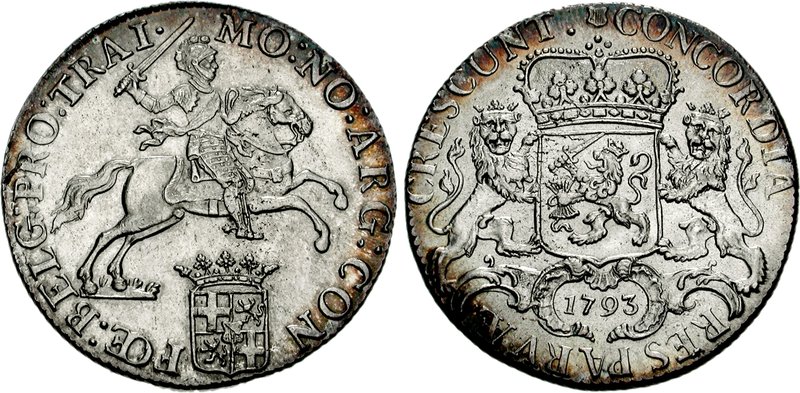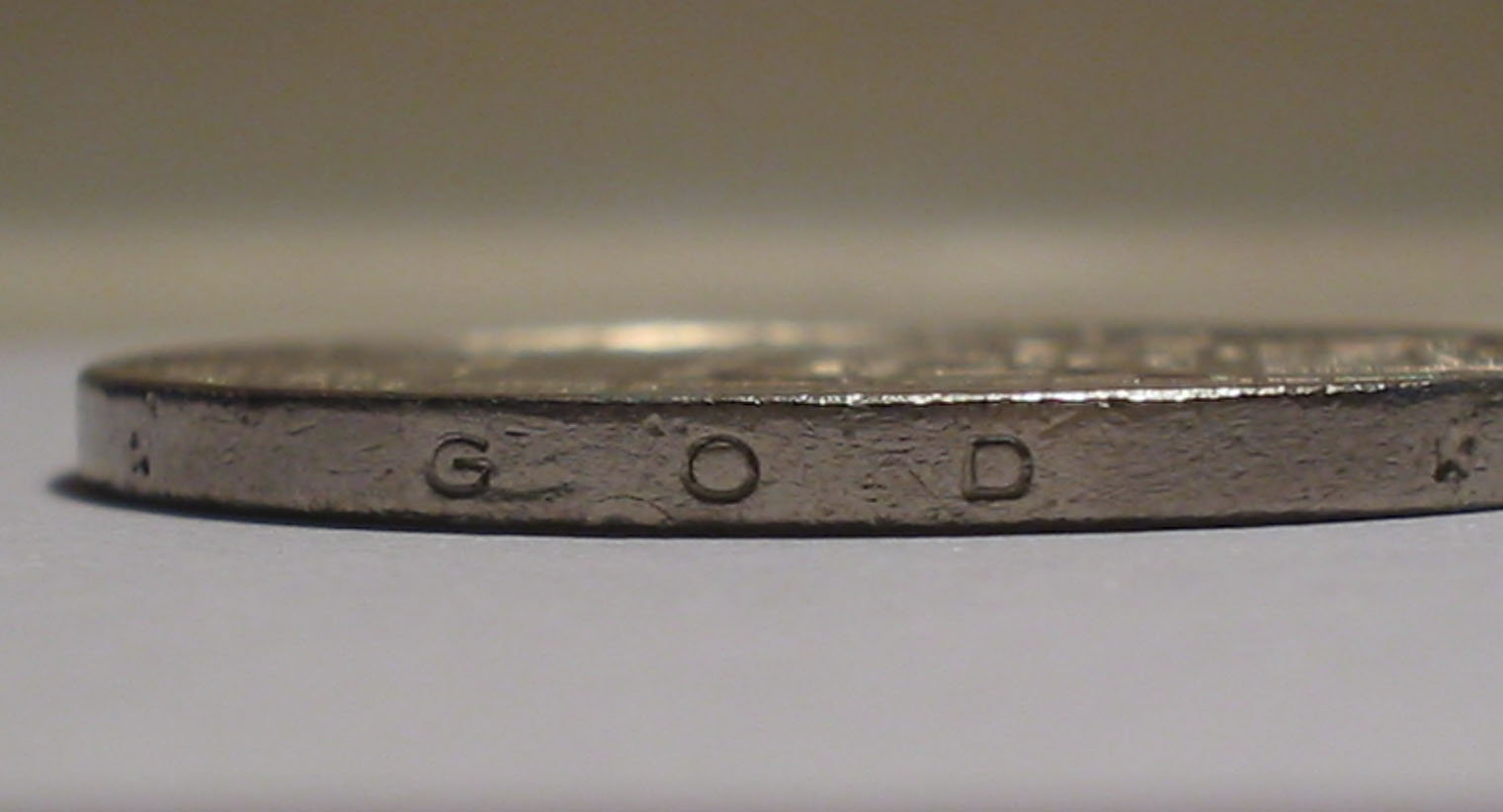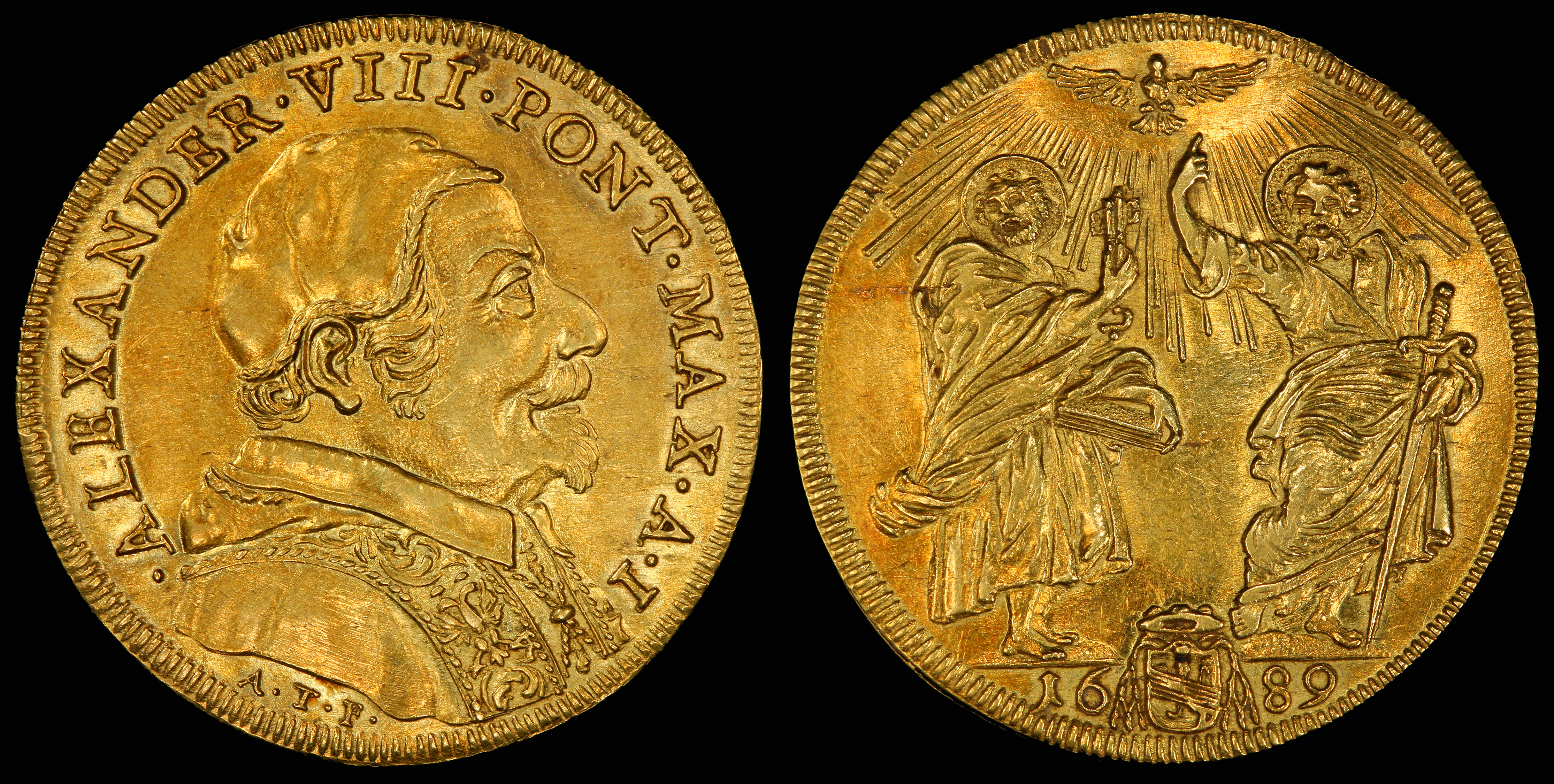|
Ducaton
The ducaton, ducatone or ducatoon was a crown-sized silver coin of the 16th-18th centuries. The first ducaton-type coin was the scudo known as the 'ducatone da soldi cento' (of 100 soldi), issued by Charles V, Holy Roman Emperor, in Milan in 1551. Ducatones were produced in greater numbers in numerous Italian states through the 17th century, spreading to other parts of the Spanish Empire, including Burgundy and the Netherlands - in 1618 the ducaton was produced in Brabant and Tournai comprising 32.48 grams of 0.944 silver depicting Albert and Isabella. Silver rider In 1659 the Dutch states started production of the 'silver rider' ducaton, featuring a mounted knight on horseback. This design weighing 32.779 grams of 0.941 silver also featured the crowned arms of the United Netherlands on the reverse, with a shield below the knight indicating the province of minting. Rider ducatons were minted until 1798. In the period 1726-1751 ducatons were minted bearing the monogram of th ... [...More Info...] [...Related Items...] OR: [Wikipedia] [Google] [Baidu] |
Dutch Republic
The United Provinces of the Netherlands, also known as the (Seven) United Provinces, officially as the Republic of the Seven United Netherlands ( Dutch: ''Republiek der Zeven Verenigde Nederlanden''), and commonly referred to in historiography as the Dutch Republic, was a federal republic that existed from 1579, during the Dutch Revolt, to 1795 (the Batavian Revolution). It was a predecessor state of the Netherlands and the first fully independent Dutch nation state. The republic was established after seven Dutch provinces in the Spanish Netherlands revolted against rule by Spain. The provinces formed a mutual alliance against Spain in 1579 (the Union of Utrecht) and declared their independence in 1581 (the Act of Abjuration). It comprised Groningen, Frisia, Overijssel, Guelders, Utrecht, Holland and Zeeland. Although the state was small and contained only around 1.5 million inhabitants, it controlled a worldwide network of seafaring trade routes. Through it ... [...More Info...] [...Related Items...] OR: [Wikipedia] [Google] [Baidu] |
Ducat
The ducat () coin was used as a trade coin in Europe from the later Middle Ages from the 13th to 19th centuries. Its most familiar version, the gold ducat or sequin containing around of 98.6% fine gold, originated in Venice in 1284 and gained wide international acceptance over the centuries. Similarly named silver ducatons also existed. The gold ducat circulated along with the Florentine florin and preceded the modern British pound sterling and the United States dollar. Predecessors The word ''ducat'' is from Medieval Latin ''ducalis'' = "relating to a duke (or dukedom)", and initially meant "duke's coin" or a "duchy's coin". The first issue of scyphate billon coins modelled on Byzantine ''trachea'' was made by King Roger II of Sicily as part of the Assizes of Ariano (1140). It was to be a valid issue for the whole kingdom. The first issue bears the figure of Christ and the Latin inscription ''Sit tibi, Christe, datus, quem tu regis iste ducatus'' (meaning "O Christ, ... [...More Info...] [...Related Items...] OR: [Wikipedia] [Google] [Baidu] |
Dutch Rijksdaalder
The ''rijksdaalder'' ( Dutch, "Imperial dollar") was a Dutch coin first issued by the Republic of the Seven United Netherlands in the late 16th century during the Dutch Revolt which featured an armored half bust of William the Silent. It was the Dutch counterpart of the Reichsthaler of the Holy Roman Empire (weighing 29.232 grams of 0.889 fine silver) but weighed slightly less, at 29.03 g (448 grains) of 0.885 fine silver, reduced to 0.875 fine by the 17th century.Weight 18 engel 28 azen (29.03 g), fineness 10 twelfths, reduced to 10 twelfths. https://books.google.com/books?id=GrJCAAAAIAAJ&pg=PA356#v=onepage&q&f=false Friesland, Gelderland, Holland, Kampen, Overijssel, Utrecht, West Friesland, Zeeland, and Zwolle minted armored half bust rijksdaalders until the end of the 17th century. 17th century rijksdaalder was set to be equal to from 48 to 50 stuivers (the Dutch equivalent of shillings) and circulated along with silver florins (28 stuivers), daalders (30 stuivers), lee ... [...More Info...] [...Related Items...] OR: [Wikipedia] [Google] [Baidu] |
Crown (British Coin)
The British crown was a denomination of sterling coinage worth of one pound, or 5 shillings, or 60 (old) pence. The crown was first issued during the reign of Edward VI, as part of the coinage of the Kingdom of England. Always a heavy silver coin weighing around one ounce, during the 19th and 20th centuries the crown declined from being a real means of exchange to being a coin rarely spent, and minted for commemorative purposes only. Unlike in some territories of the British Empire (such as Jamaica), in the UK the crown was never replaced as circulating currency by a five-shilling banknote. "Decimal" crowns were minted a few times after decimalisation of the British currency in 1971, initially with a nominal value of 25 (new) pence. However, commemorative crowns issued since 1990 have a face value of five pounds. History The coin's origins lie in the English silver crown, one of many silver coins that appeared in various countries from the 16th century onwards (m ... [...More Info...] [...Related Items...] OR: [Wikipedia] [Google] [Baidu] |
Trade Coin
Trade coins are coins minted by a government, but not necessarily legal tender within the territory of the issuing country. These quasi bullion coins (in rarer cases small change) were thus actually export goods - that is, bullion in the form of coins, used to bulk buy important goods from other countries, where they could be bought at a favourable price, compared to the purchasing power of the same amount of bullion within the trade coins' country of origin. A distinction must be drawn between full value bullion trade coins, that were used in ordinary peacetime trade on the one hand, and on the other hand debased coins, that were usually made with the intention to deceive. Such debased "trade coins" were occasionally minted during times of war, e.g. the Prussian ephraimiten, silver-clad copper coins minted during the Seven Years' War. If these were ever accepted or approved as legal tender, they would be valued far below the regular coins, their value being calculated according t ... [...More Info...] [...Related Items...] OR: [Wikipedia] [Google] [Baidu] |
Coins Of Italy
A coin is a small, flat (usually depending on the country or value), round piece of metal or plastic used primarily as a medium of exchange or legal tender. They are standardized in weight, and produced in large quantities at a mint in order to facilitate trade. They are most often issued by a government. Coins often have images, numerals, or text on them. ''Obverse'' and its opposite, ''reverse'', refer to the two flat faces of coins and medals. In this usage, ''obverse'' means the front face of the object and ''reverse'' means the back face. The obverse of a coin is commonly called ''heads'', because it often depicts the head of a prominent person, and the reverse ''tails''. Coins are usually made of metal or an alloy, or sometimes of man-made materials. They are usually disc shaped. Coins, made of valuable metal, are stored in large quantities as bullion coins. Other coins are used as money in everyday transactions, circulating alongside banknotes. Usually the highest va ... [...More Info...] [...Related Items...] OR: [Wikipedia] [Google] [Baidu] |
Guilder
Guilder is the English translation of the Dutch and German ''gulden'', originally shortened from Middle High German ''guldin pfenninc'' " gold penny". This was the term that became current in the southern and western parts of the Holy Roman Empire for the Fiorino d'oro (introduced in 1252). Hence, the name has often been interchangeable with ''florin'' (currency sign ''ƒ'' or ''fl.''). The guilder is also the name of several currencies used in Europe and the former colonies of the Dutch Empire. Gold guilder The guilder or gulden was the name of several gold coins used during the Holy Roman Empire. It first referred to the Italian gold florin introduced in the 13th century. It then referred to the Rhenish gulden (florenus Rheni) issued by several states of the Holy Roman Empire from the 14th century. The Rhenish gulden was issued by Trier, Cologne and Mainz in the 14th and 15th centuries. Basel minted its own ''Apfelgulden'' between 1429 and 1509. Bern and Solothurn fol ... [...More Info...] [...Related Items...] OR: [Wikipedia] [Google] [Baidu] |
Thaler
A thaler (; also taler, from german: Taler) is one of the large silver coins minted in the states and territories of the Holy Roman Empire and the Habsburg monarchy during the Early Modern period. A ''thaler'' size silver coin has a diameter of about and a weight of about 25 to 30 grams (roughly 1 ounce). The word is shortened from ''Joachimsthaler'', the original ''thaler'' coin minted in Joachimstal, Bohemia, from 1520. While the first standard coin of the Holy Roman Empire was the '' Guldengroschen'' of 1524, its longest-lived coin was the '' Reichsthaler (Reichstaler)'', which contained Cologne Mark of fine silver (or 25.984 g), and which was issued in various versions from 1566 to 1875. From the 17th century a lesser-valued '' North German thaler'' currency unit emerged, which by the 19th century became par with the '' Vereinsthaler''. The ''thaler'' silver coin type continued to be minted until the 20th century in the form of the Mexican peso until 1914, the ... [...More Info...] [...Related Items...] OR: [Wikipedia] [Google] [Baidu] |
Stuiver
The stuiver was a coin used in the Netherlands, worth Dutch Guilders ( 16 ''penning'' or 8 ''duit'', later 5 cents). It was also minted on the Lower Rhine region and the Dutch colonies. The word can still refer to the 5 euro cent coin, which has almost exactly the same diameter and colour despite being over twice the value of the older coin. Netherlands The ''Stüber'' emerged from the ''vierlander'' ("coin of four provinces"), that Philip III of Burgundy had minted from 1434 as a common denomination for Brabant, Flanders, Holland and the Hainault (''Hennegau'') and which had a value of Rhenish ''gulden''. It corresponded to 3 Brabant ''Plakken'', 2 Flemish '' Groten'', 16 Dutch ''pfennigs'' or 1 Artesian ''schilling''. The name "stuiver" derives from the Dutch ''stuiven'' ("flying sparks"), since on early Flemish ''stuivers'' "spark-producing flints of the Collar of the Golden Fleece" were depicted. Twenty stuivers equalled a '' Dutch Guilder.'' It circulated u ... [...More Info...] [...Related Items...] OR: [Wikipedia] [Google] [Baidu] |
Spanish Dollar
The Spanish dollar, also known as the piece of eight ( es, Real de a ocho, , , or ), is a silver coin of approximately diameter worth eight Spanish reales. It was minted in the Spanish Empire following a monetary reform in 1497 with content 25.563 g = 0.822 oz t fine silver. It was widely used as the first international currency because of its uniformity in standard and milling characteristics. Some countries countermarked the Spanish dollar so it could be used as their local currency. Because the Spanish dollar was widely used in Europe, the Americas, and the Far East, it became the first world currency by the late 18th century. The Spanish dollar was the coin upon which the original United States dollar was based (at 0.7735 oz t = 24.0566 g), and it remained legal tender in the United States until the Coinage Act of 1857. Many other currencies around the world, such as the Japanese yen and the Chinese yuan, were initially based on the Spanish dollar and other 8-real c ... [...More Info...] [...Related Items...] OR: [Wikipedia] [Google] [Baidu] |
Dutch East India Company
The United East India Company ( nl, Verenigde Oostindische Compagnie, the VOC) was a chartered company established on the 20th March 1602 by the States General of the Netherlands amalgamating existing companies into the first joint-stock company in the world, granting it a 21-year monopoly to carry out trade activities in Asia. Shares in the company could be bought by any resident of the United Provinces and then subsequently bought and sold in open-air secondary markets (one of which became the Amsterdam Stock Exchange). It is sometimes considered to have been the first multinational corporation. It was a powerful company, possessing quasi-governmental powers, including the ability to wage war, imprison and execute convicts, negotiate treaties, strike its own coins, and establish colonies. They are also known for their international slave trade. Statistically, the VOC eclipsed all of its rivals in the Asia trade. Between 1602 and 1796 the VOC sent almost a million Eur ... [...More Info...] [...Related Items...] OR: [Wikipedia] [Google] [Baidu] |
Italian Scudo
The ''scudo'' (pl. ''scudi'') was the name for a number of coins used in various states in the Italian peninsula until the 19th century. The name, like that of the French écu and the Spanish and Portuguese escudo, was derived from the Latin ''scutum'' ("shield"). From the 16th century,Klütz: ''Münznamen...'' the name was used in Italy for large silver coins. Sizes varied depending on the issuing country. The first ''scudo d'argento'' (silver shield) was issued in 1551 by Charles V (1519–1556) in Milan. Under Maria Theresa and Joseph II the ''scudo d'argento'' had a weight of 23.10 g and a fineness of 896/1000. In the Kingdom of Lombardy–Venetia (under the control of the Habsburg Austrian Empire), the Lombardy–Venetia scudo was equivalent to the Conventionsthaler and was subdivided into six '' lire''. Before the Napoleonic Wars, the lira was subdivided into 20 ''soldi'', each of 12 ''denari''. Later, the lira was made up of 100 ''centesimi''. When Austria ... [...More Info...] [...Related Items...] OR: [Wikipedia] [Google] [Baidu] |








%2C_Hoorn.jpg)
